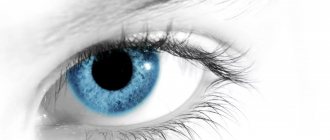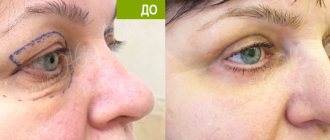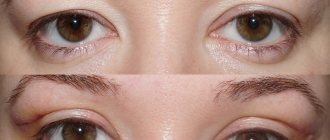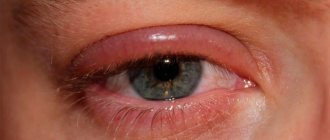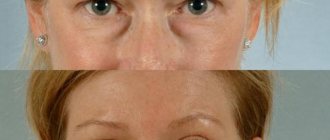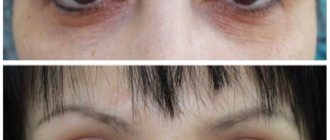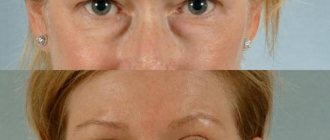Laser blepharolifting is a modern surgical way to remove excess skin from the lower or upper eyelids, get rid of facial asymmetry, drooping corners of the eyes, wrinkles and other aesthetic problems.
The advantages are the absence of incisions, postoperative sutures, scars, an easy and short rehabilitation period, minimal risk of injury to the eye structures.
Before undergoing laser eyelid lift, consult a specialist about possible risks and limitations. Pass the necessary tests and undergo a comprehensive examination. Avoid taking certain medications before the procedure that can negatively affect the results or cause complications. Do not drink or eat for 5-6 hours. Consumption of alcohol and nicotine is unacceptable.
After the operation, follow the surgeon’s recommendations: exclude creams and cosmetics, decorative cosmetics, visiting the bathhouse, sauna, and swimming pool for at least 10 days. The result and possible complications during the rehabilitation period depend on the accuracy of compliance with the prescriptions.
The effectiveness of laser blepharoplasty
Laser eyelid correction is also called blepharoplasty. It is produced using a special laser. No incisions are made with a scalpel, therefore there are no scars or stitches.
Lifting actions:
- gives expressiveness to the look;
- removes wrinkles and bags under the eyes, “crow’s feet”;
- improves the shape of the eyelids;
- rejuvenates the face as a whole.
The procedure is effective if the recommendations are followed, performed in a high-quality and qualified manner.
Immediately after a laser eyelid lift, swelling of the face, bruising in the eye area, increased tearing, and dry eye syndrome are possible. The latter reaction is accompanied by dry mucous membranes and irritation. If unwanted symptoms occur, you need to inform a specialist; it may be necessary to use special drops and medications during the rehabilitation period.
Advantages and disadvantages
Laser eyelid lift is chosen more often than other methods due to the following advantages:
- During the operation, no incision is made with a scalpel, so there are no stitches or scars;
- For the operation, a carbon dioxide or erbium laser is selected, the incision of which is much smaller than a scalpel;
- minimal tissue trauma, rapid healing of the resulting smaller wound;
- there are practically no bruises after the operation, so there is no need to mask with dark sunglasses, correctors, foundation and other decorative cosmetics during rehabilitation;
- accelerated recovery after surgery is influenced by the minimal risk of bleeding, swelling in the eye area and pain;
- minimal risk of infection entering the operated area and the development of inflammation;
- 1.5-2 hours after the procedure, the patient is examined by a specialist and sent home, since there is no need to stay in the hospital during the rehabilitation period;
- low risk of edema and hematomas due to the effect of high temperatures of the laser beam on small vessels.
The operation gives a stable effect that lasts for 4-10 years. The operation has fewer contraindications and restrictions compared to surgery.
For a better anti-aging effect and long-term preservation of the result, it is possible to combine this technique with laser resurfacing.
The procedure is carried out in stages. To eliminate a significant cosmetic defect, an average of 3-5 procedures are required at intervals of a month. The disadvantage is the high cost. The price of one procedure, depending on the type, starts from 3-3.5 thousand rubles.
The cost is influenced by the location and popularity of the clinic, the complexity and specificity of the operation, the level of service, and the provision of additional services.
Types of surgery: upper and lower blepharoplasty
Depending on the problem, the doctor may prescribe blepharoplasty of the upper or lower eyelids. In some cases, two types of correction are required at once - circular blepharoplasty.
During upper blepharoplasty, the surgeon makes an incision in the upper eyelid in the area of the natural skin fold, followed by excision of excess skin. If necessary, the surgeon removes fatty hernias. After all the necessary manipulations are completed, sutures are applied, which are almost invisible after healing.
Lower blepharoplasty is divided into two approaches to its implementation: subciliary (percutaneous) and transconjunctival. The percutaneous approach involves incision in the subciliary area and is used for severe sagging skin. Transconjunctival blepharoplasty is performed through an incision in the mucosa and allows access to fatty deposits. Most surgeons are inclined to choose this approach, since it does not affect the shape of the palpebral fissure and does not leave visible scars.
Types of blepharoplasty
5 types of operation:
- correction of the lower eyelids - performed for swelling, bags under the eyes, hernia, to remove muscles, excess skin under the eyes, remove or move fatty deposits;
- upper eyelid lifting is performed to reduce overhanging tissue;
- when correcting both eyelids simultaneously, a circular operation is performed;
- correction of the eye shape is most in demand among Asian women, when the “Mongolian fold” or epicanthus is removed and a Caucasian fold is formed;
- if the ligamentous apparatus is damaged, they resort to canthopexy, which corrects the shape and expression of the eyes.
We recommend reading: Swelling after blepharoplasty
Lower eyelid blepharoplasty is performed in two ways:
- subciliary – the laser acts on the lower eyelid, cuts the tissue along the ciliary edge;
- transconjunctival - the operation is performed on the inner surface of the eyelid.
Upper blepharoplasty
Upper blepharoplasty allows you to get rid of excess and overhanging skin in the upper eyelid area. The so-called “drooping eyelid” effect is not only an aesthetic defect; due to the heaviness of the eyelids, vision deteriorates over time and the eyes become more tired.
In 90% of cases, during surgery, it is also important to remove excess fatty tissue in the upper eyelid area in order to make the look more youthful and open, and the face more attractive. Plastic surgery on the eyelids involves an incision along the natural skin fold of the upper eyelids, due to which the cosmetic seam remains completely invisible.
Eyelid correction can be performed simultaneously with surgery to eliminate the congenital pathology of eyelid ptosis. To achieve the best result and visible rejuvenation, upper blepharoplasty is performed in combination with lower blepharoplasty.
Indications for blepharoplasty
Intervention with a laser allows you to stop and eliminate age-related changes in women and men after 45 years, improve the shape and shape of the eyes, and get rid of imperfections.
Indications for laser correction:
- drooping eyelids, especially interfering with the normal vision of objects and affecting visual acuity;
- bags under the eyes;
- asymmetrical eye shape;
- wrinkles, crow's feet;
- fatty hernias of the eyelids;
- drooping corners of the eyelids;
- other deformations.
Postoperative period
The rehabilitation period after laser blepharoplasty is individual for everyone.
For reference! On average, incisions take up to two weeks to heal if there are no complications.
During this period, the patient must follow the following recommendations :
- It is advisable to sleep on your back , with your chin slightly raised.
- If you experience pain during the first few days, you can apply cooling compresses to your eyes . This will also help eliminate swelling and bruising that inevitably occurs after blepharoplasty.
- The use of decorative cosmetics for two weeks is prohibited.
- Aspirin-based medications should not be taken , as these drugs thin the blood and can cause bleeding from the incisions.
- Visiting saunas, solariums and baths is excluded .
- It is necessary to limit physical activity and sports.
- When going outside in sunny weather, you must wear sunglasses.
Scars left after surgery are a natural phenomenon.
Over the next few weeks, they usually disappear , but not completely, although in any case after laser blepharoplasty they are hardly noticeable.
Need to know! If the scars are large enough and distinct, you can resort to an additional procedure - laser resurfacing.
Resurfacing is performed using a laser, which targets scar tissue, smoothing it out.
The procedure requires an average of 5-6 sessions.
In addition to removing scars, resurfacing also helps stimulate the inner layers of the dermis, which begins to produce collagen and elastin.
Due to this, the skin gains elasticity, smoothness and natural color.
Contraindications
Laser eyelid correction is one of the safest procedures. However, due to the use of a high-temperature beam and a minimal incision to prevent complications, not everyone can undergo surgery.
Contraindications:
- HIV infection;
- diseases of the endocrine system, diabetes;
- increased sensitivity to the technique used;
- exacerbation of any chronic disease;
- inflammatory process occurring at the intended site of laser correction;
- any tumors, malignant or benign oncological formations;
- increased arterial and intraocular pressure;
- hemophilia, other blood diseases.
It is not recommended to perform blepharoplasty during pregnancy and lactation due to insufficient research and possible harm to the health of the mother and baby.
Advantages of the EMC Clinic
Plastic surgery on the eyelids includes a number of different correction options and requires the highest qualifications and precision from the specialist. Blepharoplasty at the EMC clinic is the best plastic surgery specialists with international practice and extensive practice, mastering the most complex methods of eyelid correction.
Innovative technical equipment, a modern fully equipped operating unit, the possibility of a comprehensive examination before surgery, and a postoperative hospital allow the EMC Aesthetic Clinic to maintain the highest level of medicine in Moscow.
Preparing for surgery
Preparatory activities:
- choose a trusted clinic and doctor based on diploma, certificates and positive reviews;
- visit a specialist for a preliminary consultation;
- undergo an examination, take a general urine and blood test, blood test for HIV;
- examination by an ophthalmologist to exclude infectious and inflammatory eye diseases;
- setting a date for blepharoplasty;
- 2 weeks before the scheduled date of the procedure, use sunscreen on your face before going outside;
- 5 days before lifting, stop taking blood thinning drugs (Aspirin, Acetylsalicylic acid, Thrombo ass, Cardiomagnyl, Clopidogrel and others), after consulting with your doctor;
- 2 weeks in advance, also give up medications that increase photosensitivity (some antibiotics, medications and cosmetics for acne, hormonal agents, NSAIDs - ketoprofen, diclofenac and others);
- give up alcoholic beverages, narcotic and psychotropic substances, and nicotine.
Performing laser blepharoplasty
The procedure is performed on an outpatient basis, without a long hospital stay. For lifting, local or general anesthesia and cream are used.
A protective lens is placed on the pupil, and the doctor marks the eyelids. Before the tightening procedure, a cream with an anesthetic effect (Emla, Acriol) is applied to the selected area.
After the effect of the anesthetic drug occurs (approximately 10-15 minutes), the doctor cuts the tissue and adjusts the eyelids. Then the edges of the wound are stitched.
Eyelid lift surgery takes on average 20-30 minutes. To eliminate various problems, one procedure is not enough; on average, 2-5 are required.
To prevent unwanted reactions (swelling, infection, pain), medications are prescribed.
Possible complications:
- swelling and hematomas;
- dry eye syndrome disappears in 2-3 weeks;
- asymmetry of the eyelids;
- when using carbon dioxide, tissue burns;
- pain after surgery is relieved by taking painkillers and instilling prescribed drops.
Surgery and rehabilitation period
Surgical eyelid correction can be performed under either local or general anesthesia. The duration of the operation is from 30 minutes to 1 hour.
The recovery period after blepharoplasty is quite short. There is virtually no pain during the rehabilitation period. On the third day after the operation, the sutures are removed, and after two weeks the bruises and swelling disappear without a trace. A week after the operation, you can already apply makeup.
The combination of blepharoplasty with a check-lift (an operation that eliminates sagging skin and shifts the muscle complex of the cheeks upward) allows you to get excellent results with minimal surgical intervention. Both operations are performed through a neat incision under the eyelash edge, which heals almost without a trace.
In most cases, the scarring process in the area of incisions performed during eyelid surgery occurs without complications and does not require additional measures to improve the quality of the scars. Sometimes, in order to speed up rehabilitation, a course of physiotherapeutic treatment is prescribed.
Rehabilitation
The postoperative period lasts 1-2 weeks. During this time, the following recommendations should be followed:
- apply cooling compresses to reduce tissue swelling;
- for the same purpose, for better results and the absence of complications, do not sleep on your stomach and with your face in the pillow, the desired position is on your side or back, with your head slightly raised;
- protect the skin around the eyes from sun rays by using a special sunscreen suitable for the face with a factor of at least 40-45 (preferably 45-55 spf);
- do not lift heavy objects, avoid strong physical activity during the rehabilitation period;
- exclude blood thinning medications (Warfarin, Clopidogrel, Aspirin and others);
- do not use decorative cosmetics, especially in the eye area;
- do not stay in the sun for a long time, refrain from visiting the bathhouse, sauna, solarium.
If it is necessary to use medications to thin the blood and it is impossible to discontinue the medications, consult a surgeon and cardiologist (for example, the risk of heart attack, thrombosis).
We recommend reading: Photos by day after blepharoplasty
A specialist will give more detailed recommendations for the postoperative period, taking into account the questions asked and the patient’s characteristics.
The duration of the rehabilitation period depends on the lifting technique. With surgical laser blepharoplasty, it lasts 2-3 weeks. With a non-surgical method – up to 5-7 days.
General provisions
1.1 The site administrator (hereinafter referred to as the Operator) makes respect for the rights and freedoms of citizens one of the most important conditions for carrying out its activities.
1.2 The Operator’s policy regarding the processing of personal data (hereinafter referred to as the Policy) applies to all information that the Operator can obtain about visitors to the dr-vedrov.ru website. Personal data is processed in accordance with the Federal Law “On Personal Data” No. 152-FZ.
Basic concepts used in the Policy:
2.1 Website - a collection of graphic and information materials, as well as computer programs and databases that ensure their availability on the Internet at the network address dr-vedrov.ru;
2.2 User – any visitor to the dr-vedrov.ru website;
2.3 Personal data – any information relating to the User of the dr-vedrov.ru website;
2.4 Processing of personal data - any action with personal data performed using a computer, as well as without their use;
2.5 Depersonalization of personal data – actions that result in the impossibility of determining the ownership of personal data to a specific User or person without the use of additional information;
2.6 Distribution of personal data – any actions that result in the disclosure of personal data to an indefinite number of persons;
2.7 Providing personal data – any actions that result in the disclosure of personal data to a certain circle of persons;
2.8 Destruction of personal data – any actions that result in the irreversible destruction of personal data on a computer or any other media.
The operator may process the following personal data:
3.1 User's email address
3.2 User's phone number
3.3. Last name, first name, patronymic of the User
3.4. The site also collects and processes anonymized data about visitors (including cookies) using Internet statistics services (Yandex Metrica and Google Analytics and others).
Purposes of processing personal data
4.1 The purpose of processing the User’s email address, phone number, last name, first name, patronymic is to clarify the details of the service. The Operator also has the right to send notifications to the User about new products and services, special offers and various events. The User can always refuse to receive information messages by sending a letter to the Operator to the address [email protected]
4.2 Anonymized data of Users, collected using Internet statistics services, is used to collect information about the actions of Users on the site, improve the quality of the site and its content.
Legal grounds for processing personal data
5.1 The Operator processes the User’s personal data only if it is sent by the User through the forms located on the dr-vedrov.ru website. By sending his personal data to the Operator, the User expresses his consent to this Policy.
5.2 The Operator processes anonymized data about the User if this is allowed in the User’s browser settings (saving cookies and using JavaScript technology are enabled).
The procedure for collecting, storing, transferring and other types of processing of personal data
6.1 The Operator ensures the safety of personal data and takes all possible measures to prevent access to personal data by unauthorized persons.
6.2 The User’s personal data will never, under any circumstances, be transferred to third parties, except in cases related to the implementation of current legislation.
6.3. If inaccuracies in personal data are identified, the User can update them by sending a notification to the Operator via email to the Operator's email address, marked “Updating personal data”
6.3 The period for processing personal data is unlimited. The User may at any time withdraw his consent to the processing of personal data by sending a notification to the Operator via email to the Operator's email address [email protected] , marked “Withdrawal of consent to the processing of personal data.”
Final provisions
7.1. The user can receive any clarification on issues of interest regarding the processing of his personal data by contacting the Operator via email [email protected]
7.2. This document will reflect any changes to the Operator’s personal data processing policy. In case of significant changes, the User may be sent information to the email address specified by him.
Reviews from doctors
Anna Gennadievna, surgeon: Laser blepharoplasty is safe. For serious indications, more than 5 procedures are required in combination with other methods. After surgery, it is important to follow the specialist’s recommendations. Do not hesitate to ask and contact us if unwanted effects occur. Sometimes there is dry eye syndrome, severe swelling of the eyelids and pain. These conditions require the use of special medications.
Alina Viktorovna, cosmetologist: Laser eyelid lifting is recommended if other safe cosmetic methods are ineffective. During blepharoplasty, special attention should be paid to protecting the skin around the eyes from ultraviolet rays and injury. For a lasting result, you will need not one, but at least 3-5 procedures.
Sergey Vladimirovich, surgeon: Often it is necessary to correct complications after blepharoplasty performed by dubious specialists and in non-specialized institutions. The procedure itself is painless, safe, complications rarely arise if the doctor is sufficiently qualified and the patient follows the recommendations in the postoperative period.
How does the laser method differ from the surgical method?
During blepharoplasty , a scalpel is used .
Know! Laser blepharoplasty is performed using a medical laser and, unlike a surgical procedure, produces less noticeable scars.
If during surgery severe hemorrhages can occur due to damage to blood vessels and capillaries, then during laser surgery the damaged vessels are immediately cauterized with a laser beam.
Therefore, such consequences can be avoided.
The laser used during surgery serves not only to excise tissue.
It performs several functions, including creating microscopic burns , which prevent the entry of pathogenic microorganisms and reduce the risk of secondary infection.
Patient reviews
Albina: 1.5 years ago she had a hernia removed under her eyes. I was pleased with the effect and the result lasted. For the first time after the operation, I was bothered by swelling and severe pain.
Galina: 3 years ago I had circumferential blepharoplasty on both eyes, upper and lower eyelids. After the operation I was upset - severe swelling, bruising, discomfort and dry eyes. Within 2-3 weeks the symptoms disappeared, but the results remained.
Lyudmila: I had 4 procedures to lift the upper and lower eyelids. After the 2nd procedure, the eyelid was noticeably tightened, wrinkles and crow's feet disappeared. After 4 procedures, the result intensified, but did not last long. 3 months after blepharoplasty, wrinkles appeared again, there is no feeling of “sunken” eyes.
Video of laser blepharoplasty
Complications after laser correction of the upper and lower eyelids, possible causes of adverse reactions and the best age for a lift.
Author's rating
Author of the article
Alexandrova O.M.
Articles written
2100
about the author
Was the article helpful?
Rate the material on a five-point scale!
( 5 ratings, average: 3.20 out of 5)
If you have any questions or want to share your opinion or experience, write a comment below.
Transconjunctival (sutureless) blepharoplasty
The essence of the operation is that the surgical incision is located along the line of the conjunctiva, that is, on the inside of the lower eyelid. Hence the second name - “sutureless”, since sutures are not required after transconjunctival blepharoplasty: the dissected area located on the mucous membrane heals on its own.
In this regard, laser blepharoplasty is more profitable than traditional blepharoplasty - the surgeon removes excess fatty tissue through small punctures, which he makes with a laser beam. Under the influence of laser radiation, cellular processes are activated, provoking more intense tissue regeneration.
Accordingly, the rehabilitation period is significantly reduced: complete recovery occurs in three days, minor swelling and bruising disappear on their own within a week and a half.
In addition to all of the above, the laser is used by the surgeon to renew the skin of the lower eyelids, eliminate facial wrinkles and the first age wrinkles: after completing work on eliminating the hernia formation, the doctor performs laser resurfacing of the eyelids.
Laser transconjunctival blepharoplasty allows you to perform two operations in one operation: to eliminate a cosmetic defect in the form of fatty hernias and to tighten, make the skin of the lower eyelids more elastic and smooth.
It is recommended only for those patients who have not yet been diagnosed with age-related ptosis (tissue drooping) in the area under consideration, characterized by a significant amount of excess soft tissue.
To correct age-related aesthetic deficiencies in the periorbital area, more complex techniques are recommended that require large-scale surgical intervention using traditional surgical instruments.
You can learn more about transconjunctival blepharoplasty here
Progress of laser blepharoplasty surgery
The duration of the procedure is from 30 to 90 minutes (on average 45 minutes) and depends on the complexity and volume. Before performing the operation, I will select the appropriate technique to obtain the best results, taking into account your wishes, physiological characteristics and health status.
Step 1 - Anesthesia
Usually a combination of local anesthesia and light intravenous sedation is used, however, with a large volume of surgical intervention, the choice may fall towards general anesthesia. In our clinic, pain relief is always carried out under the guidance of one of the best anesthesiologists in the country, which guarantees your safety and the absolute safety of your health.
Step 2 - Cuts
The incision lines depend on the type of plastic surgery performed and are always located in the natural folds of the skin, which makes the seams and scars completely invisible to the prying eye!
Step 3 - Closing the Cuts
Sutures are usually closed:
- Removable or absorbable threads
- Leather glue
- Surgical tape
- When performing “seamless” laser transconjunctival plastic surgery, no sutures are required.
In the video: a 54-year-old patient diagnosed with hernias and excess skin of the upper and lower eyelids. Atony of the lower eyelids. In addition, the patient has a scleral gaze and a negative vector. In general, the conditions for blepharoplasty “cannot be worse.” Severe excess skin, hernias of the upper and lower eyelids are also visualized. The planned operation includes: circumferential blepharoplasty with myopexy and canthopexy in the lower eyelid area. This volume of surgery will minimize the risk of postoperative complications. A prerequisite for successful rehabilitation in such situations is anti-scar physiotherapy. As a rule, this is ultraphonophoresis with longidase.
